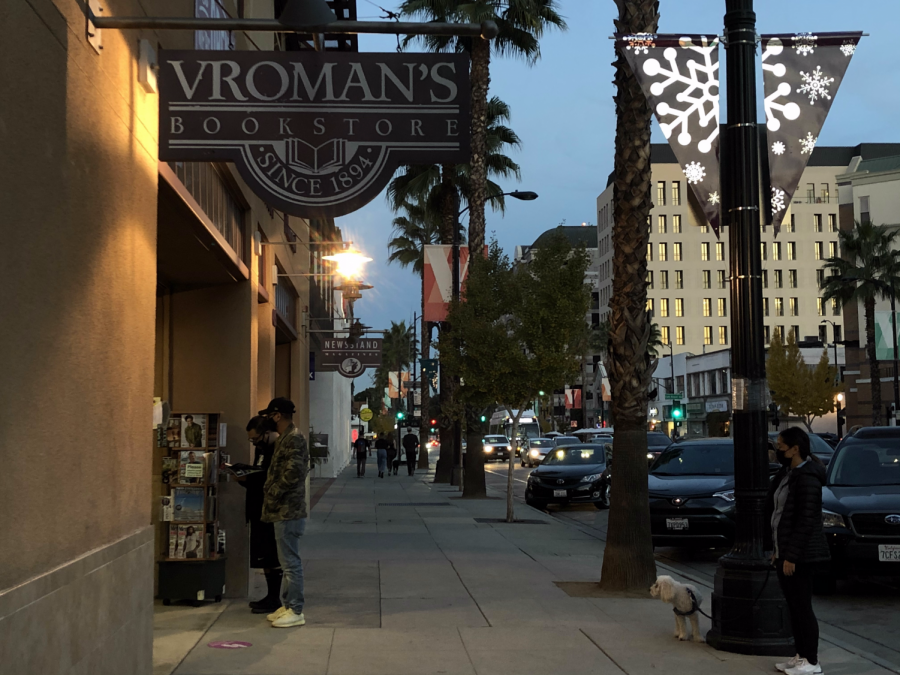In today’s world, stories are discovered through digital media — via social platforms, videos, and streaming apps. Many readers have embraced the shift, choosing speed and convenience over slow discovery. But while digital reading isn’t without value, something important gets lost in the scroll. More and more people are beginning to recognize what local bookstores still offer: a personal connection to stories, spaces for community, and the joy of discovering something you didn’t know you were looking for.
The Shift to Digital Reading
In recent years, digital reading has become increasingly popular and common. From Kindles to Nooks, to reading apps, more readers have turned to e-reading for convenience. For those on the go, or those who want to swap doom-scrolling for something more meaningful, digital formats offer accessible and flexible forms of reading.
When asked if she prefers digital books or physical ones, GCC freshman Raelyn Ramirez said she’s a bit of both. “It depends on my mood,” she said, describing herself as a mood reader. “I use physical books if I’m at home or at school, but if I’m out and about, I love using my Kindle.”
E-books have opened the door for many to read more often, in more places, without the need to carry a physical book around. Hannah Garcia, a freshman at GCC, has a preference for physical books, but still acknowledges the convenience and appeal of e-reading. “They’re easier to access,” she said. “But maybe a bit tougher to really connect with.”
This is where digital reading has begun to lose its charm. As much as it is convenient and worthwhile, there are some things that digital literacy cannot replace from physical literacy, and there are things that digital reading has done that has changed reading. “I just think what’s changed most is our attention span,” said writer and GCC educator Kate Martin Rowe. “Even someone like me who I make a living with words, you know, and it’s hard. That’s like a never-ending battle to maintain or strengthen my attention span.”
People have begun to prefer shorter pieces of writing as opposed to long-form content, which is something writers have started to consider as well as begin to adapt to. Rowe adds on to this shift of change. “People are saying you shouldn’t write a long essay anymore, because readers won’t stick with it. As writers, we have to consider that. Maybe that’s not all bad—but it does mean something is being lost.”
The Role of Social Media
Social media has become our daily norm. Everything has adapted and shifted to social platforms. There is always a debate on whether social media is good or bad, convenient or a nuisance, etc. It will always be both, and there are many ways social media has contributed to the book community, as well as harming it.
Platforms like TikTok and Instagram influence what books get pushed to the mainstream and which people shouldn’t read. People have become accustomed to listening to what others are saying, rather than discovering the types of books they’ll like on their own.
“People read books not based on substance but because they’re popular,” Ramirez said. “I won’t yuck someone’s yum but they continue to promote books that makes me question what was its purpose. Honestly it sucks that people only pick up books that are “trending” and lie about its content.”
Harmful as it may be, social media platforms have also welcomed new readers to begin to explore their reading journeys, as well as finding out local bookstores they can visit. Garcia looks at the more positive side of this.
“Social media is a great way for bookstores to shine. They can use platforms like Instagram or TikTok to show off new books, do live readings, and share staff favorites or reviews,” she said. “When posts go viral—especially from influencers or fellow book lovers—it can really bring people into the store or boost online sales. It’s an awesome way to connect with readers, promote events, and build a loyal community around books.”
Big Chains vs. Independent Bookstores
Barnes and Noble is known as the biggest bookstore chain. But before it was, it used to be at the brink of bankruptcy. Amazon was on the rise, and many believed that bookstores would disappear.
“I’m old enough to remember when Amazon first came on to the scene,” Rowe said, “Everyone was talking about how it was going to be the end of bookstores.” While she supported local shops when she could, even Rowe admitted to occasionally turning to Amazon for convenience. Many use big chains such as Target, Walmart, and Amazon because it’s easier to buy books, especially if one is too busy to go to bookstores.
That started to change at the beginning of this year. Citing political frustrations and Amazon’s business practices, Rowe said, “I haven’t bought anything from Amazon since February. It feels like a small but meaningful way to take action.” Many on social media have encouraged their audiences to support bookstores during this time. Bookstores have started to become more popular with many readers shopping to show their support.
Why Supporting Bookstores Matters
Experiences in bookstores are like no other. From entering into a new setting, to spending hours browsing shelves to find the perfect book. It’s one of the many reasons why supporting bookstores matters. They offer community, discovery, and opportunities.
“When I’m in a bookstore, a lot of times it’s because I’m going to a reading, so that’s really inspiring and a place that I find community,” Rowe said. Rowe goes to her local bookstores to attend readings and discover new and upcoming authors.
Bookstore events offer opportunities for authors to share their work and meet readers. It’s one of the ways in which they build community. “Local bookstores allow space for authors to promote books that might not be pushed by the market,” said Ramirez. “I find books I’ve never even heard of that end up becoming favorites.”
Building community in bookstores can also be talking with other readers and employees. Engaging in random discussions about books and writings is a great way to create connection and familiarity with people at your local bookstores. “Bookstores definitely offer a space of community. If I see someone pick up a book I’ve read, I like striking up a conversation about the book,” said Ramirez.
Being at a bookstore is a space where you can wander without a rush, taking the time to explore. It allows you to be present, slow, and mindful. “When you’re at a bookstore, you’re there to do maybe one thing, which is look for a book, or go to a reading. So you’re automatically in a space that’s just slower and requires you to be more present in your body and in your mind,” said Rowe.
Supporting bookstores means creating and building community, having safe spaces for both readers and writers, and experiencing the feeling of getting lost in the world of books, and being immersed in it. All bookstores appreciate customers who stop in to browse, find new things or what they wanted, or buy something.
7 Local Bookstores To Visit and Support
Where can you begin your journey of visiting bookstores? There are many local ones you can support, and here are a few you should check out:
Skylight Books – Located in Los Feliz, this bookstore has a tree growing in the middle of the store. It’s cozy, and has events you can check out here. Address: 1818 N Vermont Ave, Los Angeles, Calif., 90027. Hours: Daily, 10 a.m. – 10 p.m.
Vroman’s Bookstore – Located in Pasadena, it is the oldest bookstore in Southern California, founded in 1894. They host over 400 community events annually. Address: 695 E Colorado Blvd, Pasadena, Calif., 91101. Hours: Monday – Saturday: 10 a.m. – 9 p.m.; Sunday: 10 a.m. – 7 p.m.
Octavia’s Bookshelf – Also located in Pasadena, it is Pasadena’s first Black-owned bookstore. They have various collections and books by black authors, and was inspired by Parable of the Sower author Octavia E. Butler. Address: 1365 N Hill Ave, Pasadena, Calif., 91104.Hours: Tuesday – Sunday: 10 a.m. – 6 p.m.; Closed on Mondays.
Lost Books – Located in Glendale, this bookstore features a unique plant-filled tunnel entrance, creating an enchanting atmosphere for visitors. Address: 2233 Honolulu Ave, Glendale, Calif., 91020. Hours: Monday – Saturday: 10 a.m. – 6 p.m..
Barnes and Noble – Located in Glendale, this three-story location offers a spacious layout with a cozy café, making it a perfect spot to relax and browse through a vast selection of books. Address: 210 Americana Way, Glendale, Calif., 91210. Hours: Daily, 10 a.m. – 9 p.m..
The Iliad – Located in North Hollywood, it is one of the largest used bookstores in Los Angeles, it boasts over 100,000 books and is home to two resident cats, Apollo and Zeus. Address: 5400 Cahuenga Blvd, North Hollywood, Calif., 91601. Hours: Tuesday – Saturday: 11 AM – 7 p.m.; Closed on Mondays.
The Last Bookstore – Located in Downtown, Los Angeles. This store is known for its vintage
and artsy atmosphere, as well as their infamous book arch. Address: 453 S Spring St, Los
Angeles, Calif., 90013. Hours: Daily, 11 a.m. – 8 p.m.
Visiting and supporting local bookstores opens the door to more than just buying books. These spaces create opportunities for writers and book lovers, communities, events, discovering unexpected titles, and connecting with others who share a love for stories. Whether you’re a casual reader or a lifelong book lover, bookstores keep literature personal and the communities around it alive.
Sirey Rivas can be reached at [email protected].


